UP Board Solutions For Class 9 Science Chapter 11 Sound Very Short Answer Type Questions
Question 1. What is the name of the strings which vibrate in our voice box when we talk?
Answer:
Vocal cord.
Question 2. How would you communicate in an atmos-phereless region?
Answer:
We can communicate through wireless sets using radio waves because radio waves can travel without a medium.
Question 3. If a freely suspended vertical spring is pulled in a downward direction and then released, which type of waves are produced in the spring?
Answer:
In this situation, longitudinal waves will be produced in spring.
Question 4. If a stone is dropped on the surface of water in a pond. Which type of waves are produced in water?
Answer:
In this situation, transverse waves will be produced in water.
Question 5. Give one example of a transverse and longitudinal wave.
Answer:
Example of a transverse and longitudinal wave
Transverse wave – Light
Longitudinal wave – Sound
Question 6. A baby recognises her mother by her voice. Name the characteristic of sound involved.
Answer:
Quality of the sound is that characteristic of sound due to which distinction can be made between two sounds.
Question 7. On what factor does the quality of the sound depend?
Answer:
The quality of the sound depends on the shape of the sound wave.
Question 8. Why do we hear the loud sound of the horn of an approaching car before the car reaches us?
Answer:
This is because the velocity of the soul is much greater than that of the car.
Read and Learn More Class 9 Science Solutions
Question 9. Among air, water and steel, in which medium, the sound wave will travel faster?
Answer:
The sound wave will travel faster in steel because the speed of sound is the fastest in the solids.
Question 10. How does temperature affect the speed of sound?
Answer:
The speed of sound increases with the increase in temperature.
Question 11. Give the correct picture of the reflection of sound marked with the angle of incidence, angle of reflection and the normal.
Answer:
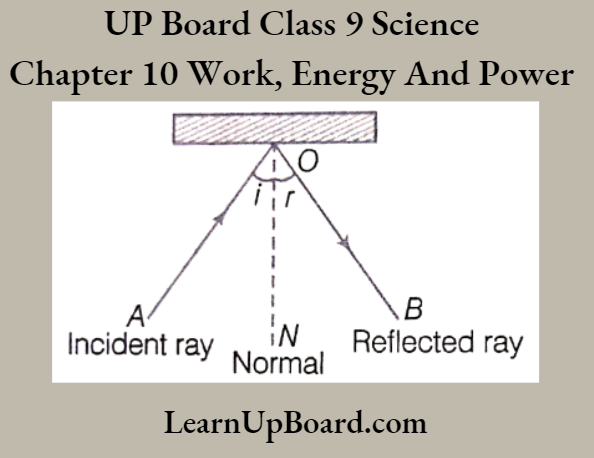
- \(\angle i\)= angle of incidence,
- \(\angle r\)=angle of reflection
Question 12. From which type of surface, the reflection of sound is better?
Answer:
The hard surface is a better reflector of sound.
Question 13. Give examples of multiple echoes.
Answer:
Examples of multiple echoes
- Rolling of thunder,
- Whispering galleries.
Question 14. At 20°C, what should be the minimum distance of a person from a sound-reflecting surface to hear an echo?
Answer:
The minimum distance from the sound-reflecting surface to hear an echo should be at least 17.2 m.
Question 15. Why are roofs and walls of an auditorium/hall generally covered with sound-absorbent materials?
Answer:
To reduce reverberation, the roofs and walls of an auditorium or hall are generally covered with sound-absorbent materials.
Question 16. Name the phenomenon responsible for the rolling of thunder.
Answer:
It is due to multiple reflections of sound from objects like clouds, land, etc.
Question 17. Why should the curved soundboard be placed behind the stage?
Answer:
It is because, after reflection from the curved sound hoard, sound waves spread evenly apart the width of the hall.
Question 18. What kind of waves are produced in an earthquake before the main shock wave begins?
Answer:
Infrasonic waves are produced in an earthquake before the main shock wave begins.
Question 19. State two important uses of ultrasounds for medical purposes.
Answer:
- Diagnosing the tumours in the human body.
- To analyse the development of the foetus.
Question 20. What is the frequency of the wave with a period of 0.025 s?
Answer:
Given, T=0.025 s
v=\(\frac{1}{T}=\frac{1}{0.025}\)=40 Hz
Question 21. A human heart beats 72 times in a minute. Calculate its frequency.
Answer:
Frequency =\(\frac{\text { Number of beats }}{\text { Total time }(\text { in second) }}\)
= \(\frac{72}{60}=1.2 \mathrm{~Hz}[1 \mathrm{~min}=60 \mathrm{~s}]\)
UP Board Solutions For Class 9 Science Chapter 11 Sound Short Answer Type Questions
Question 1. Why do astronauts talk to each other through radiotelephone?
Answer:
As sound waves cannot travel through a vacuum in space. So, they use electromagnetic waves such as radio waves to communicate as it does not require a medium for propagation.
Question 2. Why are the longitudinal waves also called pressure waves?
Answer:
It is because longitudinal waves travel in a medium as a series of alternate compressions and rarefactions, i.e. they travel as variations in pressure. Therefore, they are called pressure waves.
Question 3. When the wire of a guitar is plucked, what types of waves are produced in
- air
- wire
Give reasons in support of your answer.
Answer:
- When the wire of a guitar is plucked, a longitudinal wave is produced in the air due to the to-and-fro motion of the string of the guitar.
- In the wire of a guitar, the transverse wave is produced as the particle vibrates perpendicular to the direction of motion.
Question 4. Through what type of medium, can
- the transverse waves and
- the longitudinal waves be transmitted? Explain in brief.
Answer:
(1) Since transverse waves travel in the form of crests and troughs, the)’ involves changes in the shape of the medium.
So, they can be transmitted through a medium having elasticity of shape. As solids and liquids have elasticity of shape, hence transverse waves can be transmitted through solids and liquids.
(2) Since longitudinal waves travel in the form of compressions and rarefactions, they involve changes in the volume and density of the medium.
All media, i.e. solids, liquids and gases have elasticity of volume. Hence, these waves (longitudinal waves) can be transmitted through all three types of media.
Question 5. Name the types of waves and two examples associated with
- compressions and rarefactions
- crests and troughs.
Answer:
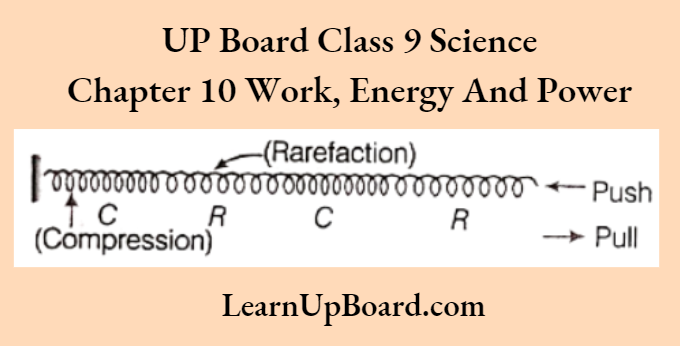
- The waves which travel along a slinky when it is pushed and pulled at one end, are the longitudinal waves. The following figure shows longitudinal waves.
- The waves produced by moving one end of a long rope (or spring) up and down rapidly whose other end is fixed, are transverse waves as shown
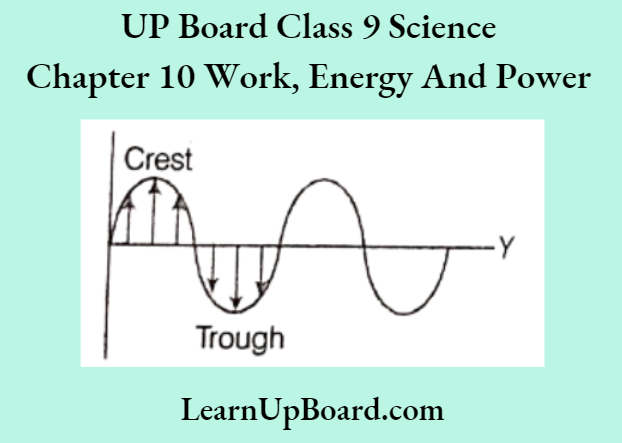
Question 6. When the wire of a sitar is plucked, what kind of waves are produced in
- the wire and
- air
Answer:
- Transverse waves are produced in the wire.
- Longitudinal waves are produced in the air.
Question 7. Why the waves produced by a motorboat sailing in the sea, are both longitudinal and transverse?
Answer:
Longitudinal waves are produced due to vibrations of the rudder inside the sea water but on the surface of the water, transverse waves are generated. Hence, waves produced by motorboats are both longitudinal and transverse
Question 8. At what frequency, a source produces 500 sound waves per second?
Answer:
The frequency of sound waves is called the number of waves, produced in 1 s.
Here, several waves are produced in 1 s = 500 So, the frequency of this sound wave is 500 Hz.
Question 9. What happens to the wavelength, velocity and frequency of sound waves, when it travels from one medium to another?
Answer:
When a sound wave travels from one medium to another medium, its wavelength as well as velocity may change. But frequency does not change.
Question 10. Some animals get disturbed before the earthquakes. Give reason.
Answer:
During earthquakes, some animals get disturbed because earthquake produces low-frequency infrasound before the main shock waves, which is audible to some animals.
Question 11. Which of the two graphs (1) and (2) representing the human voice is likely to be the male voice? Give a reason for your answer

Answer:
Graph (1) represents the male voice. Since the pitch and frequency of the male voice are lower than the pitch of the female voice vibration of the graph (2) represents a higher frequency and higher pitch.
Question 12. Waves of frequency 100 Hz are produced in a string as shown. Give its
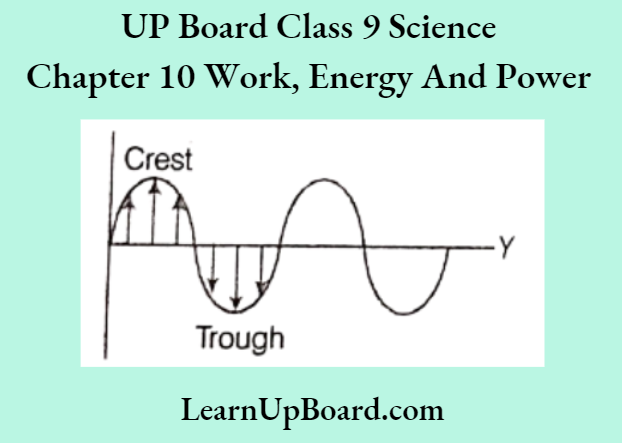
- Amplitude
- Wavelength
- Velocity
- Nature
Answer:
- Amplitude = 5 cm
- Wavelength – 20 cm
- Velocity, v=\(v \lambda=100 \times 20 \times 10^{-2}=20 \mathrm{~ms}^{-1}\)
- Nature It is a transverse wave.
Question 13. What is wave motion? Write any four characteristics of wave motion.
Answer:
Wave motion
- Wave motion is nothing but a mode of transfer of energy from place to place periodically without material transport.
Four characteristics of wave motion are:
- It is the disturbance which travels forward through the medium but not the particles of the medium.
- Each particle receives vibrations a little later than its preceding particle.
- The wave velocity is different from the velocity of the particles with which they vibrate about their mean positions.
- The wave velocity remains constant in a given medium, whereas particle velocity changes continuously during its vibrations about the mean position.
Question 14. The graph shows a trace of a sound wave which is produced by a particular tuning fork.

- Draw a trace of the sound wave which has a higher frequency than that shown
- Draw a trace of the sound wave which has a larger amplitude than that shown
Answer:
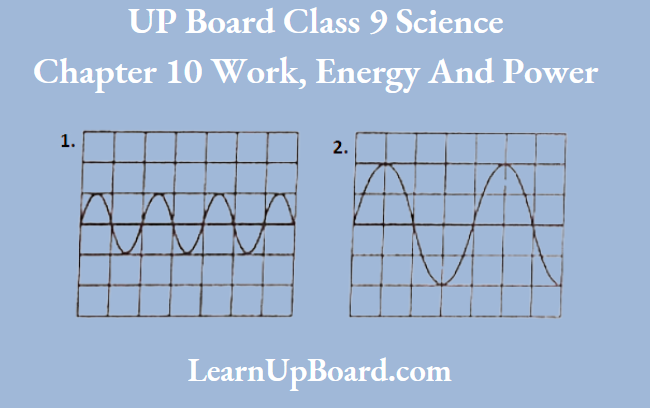
- The property which leads to the formation of echoes is the reflection of sound. When a sound is repeatedly reflected and if the minimum distance between the sound source and the reflecting surface is more than 17.2 m, then we hear echoes.
- If the reverberation time in a big hall is too long, then the sound becomes distorted, blurred and confusing.
Question 15. Give the basic difference between wave velocity and particle velocity.
Answer:
The basic difference between wave velocity and particle velocity
The wave velocity is constant for a given medium and is expressed by v = vA, while the particle velocity changes with time. It is maximum at the mean position and zero at the extreme position.
Question 16 (1) Which property of sound leads to the formation of echoes? Briefly explain.
(2) What will happen, if the reverberation time in a big hall is too long?
Answer:
The property which leads to the formation of echoes is the reflection of sound. When a sound is repeatedly reflected and if the minimum distance between the sound source and reflecting surface is more than 17.2 m, then we hear echoes.
If the reverberation time in a big hall is too long, then the sound becomes distorted, blurred and confusing.
Question 17. What is meant by the loudness of sound? State the factor on which it depends. Draw figures to illustrate
- soft sound and
- loud sounds.
Answer:
Loudness of sound
- Loudness is the measure of sound energy reaching the ear per second. The greater the sound energy reaching our ears per second, the louder the sound will appear to be.
- It depends on the amplitude of the sound wave, which depends upon the force with which an object is made to vibrate.
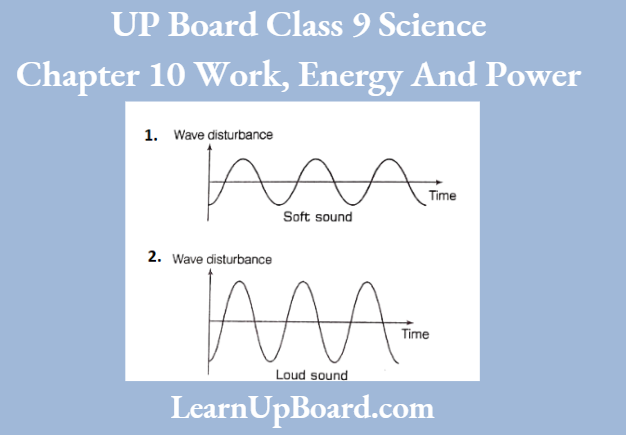
Question 18. A nail was gently touched by the hammer and then was hit harder.
- When will be the sound created louder?
- Which characteristic of sound here is responsible for the change in sound?
Answer:
- Sound will be produced when we beat hard on the nails.
- The amplitude of the vibrating body is responsible for the change in sound.
Question 19. State the conditions required to hear an echo.
Answer:
The conditions to hear an echo are
- The time interval between source sound and reflected sound must be at least 0.1s.
- The minimum distance between the obstacle and the source of sound should be at least 17.2 m.
Question 20. When can we distinctly hear the echo of a sharp sound? Why cannot we hear an echo in a small hall?
Answer:
- As we know, to listen to echo for a sound wave whose speed in air is 344 ms1 and persistence of sound is 0.1 s, a minimum distance of 17.2 m between the observer and reflecting surface is required.
- The condition of the minimum distance between the die source and the reflecting surface is not satisfied, so in a small hall, we do not hear echoes.
Question 21. Explain the rolling action of thunder.
Answer:
Rolling action of thunder
The rolling of thunder is due to multiple reflections of the sound of thunder from a number of reflecting surfaces such as clouds and land as several echoes may be heard.
Question 22. Distinguish between the terms
- music and noise
- tone and note.
Answer:
(1) Music The sound which is pleasant to the ears is called music. It is produced by regular periodic vibrations. There is no sudden change in loudness, e.g. Sound produced from a tabla.
Noise The sound which is unpleasant to the cars is called noise. It is produced at irregular intervals. There is a sudden change in its loudness, For Example. The sound produced in a market and the sound produced by an explosion.
(2) Tone The sound of a single frequency is called a tone.
Note The sound which is a mixture of several frequencies is called a note.
Question 23. When a workman hammers to one end of the long iron pipeline, an observer places his ear on the other end of the pipeline. How he can distinctly hear two sounds? Justify your answer.
Answer:
Due to the propagation of sound through solids such as iron, the sound of hammering to one end will be heard by the observer on the other end of the pipeline.
Also, the sound of hammering will be propagated through air to reach the observer.
As we know, sound travels faster in iron than in air. So, the observer hears two sounds. The first one, travelling through the iron pipeline and the second travelling through air.
Question 24. (1) Define
- infrasonic wave
- ultrasonic wave.
(2) Name two species of animals which can produce and detect
- infrasonic waves
- ultrasonic waves.
Answer:
(1) (1) Infrasonic wave The sound of frequency lower than 20 Hz is known ai infrasonic sound (or wave).
(2) Ultrasonic wave The sound of frequency higher than 20,000 Hz arc is called ultrasonic wave.
(2) (A) Animals like whales, elephants and rhinoceroses produce infrasonic sound of frequency 5 Hz,
(B) Dogs can hear and detect ultrasonic waves of frequency up to 50 Hz.
Question 25. (1) Which has a shorter wavelength infrasonic or ultrasonic?
(2) Can dolphins detect ultrasonic waves?
(3) Name any one living organism which can detect infrasonic waves.
Answer:
- The ultrasonic wave has shorter wavelengths.
- Yes, dolphins can detect ultrasonic waves.
- Rhinoceros can detect infrasonic waves.
Question 26. A key of a piano is struck gently and then struck again but much harder this time. What will happen in the second case?
Answer:
- In the second case, the key is struck harder, so the amplitude of vibration of the string increases and hence loudness increases.
- Also, frequency and hence pitch increase with an increase in force or tension in the string.
Question 27. A student went to a hill station early in the morning, he could hear the echo of his clap after 0.1 s. When he went to the same place in the afternoon he could not hear the echo at all. Explain the reason for his changed observation.
Answer:
There is a rise in temperature in the afternoon, so the speed of sound increases with an increase in temperature, As speed increases, the time taken by reflected sound will be less, which may be less than 0.1 s in the afternoon.
That is why the student could not hear the echo at all in the afternoon.
Question 28. A girl is sitting in the middle of a park of dimension 12 m x 12 m. On the left side of it, there is a building adjoining the park and on the right side of the park, there is a road adjoining the park. A sound is produced on the road by a cracker. Is it possible for the girl to hear the echo of this sound? Explain your answer.
Answer:
No, the girl can’t hear the echo of this sound because, the distance between the girl and the obstacle (building) is only 6 m approx but an echo is heard only, if the minimum distance between the observer at the source of sound and the obstacle is 11.3 m

Question 29. The wavelength of a sound wave was measured by Rohit as 8 m. The frequency of a sound wave is given as 40 Hz. What is the speed of sound as calculated by Rohit?
Answer:
Given, \(\lambda\)=8 m and v=40 Hz
As speed of sound, v= v \(\lambda=40 \times 8=320 \mathrm{~ms}^{-1}\)
Question 30. How are ultrasonic waves different from ordinary sound waves? State two applications of ultrasound.
Answer:
Ultrasonic waves have greater frequency (more than 20,000 Hz). Ordinary sound has a lower frequency than ultrasonic waves.
Due to their high frequencies,
- they have high power.
- they can penetrate anywhere to a large extent.
- they are able to travel along well-defined straight paths, even in the presence of obstacles.
Applications of ultrasound are
- To deter the flaw or defect in metal.
- In the diagnosis of diseases.
Question 31. An echo is heard on a day when the temperature is about 22°C. Will echo be heard sooner or later, if the temperature increases to 40°C?
Answer:
An echo will be heard sooner than the echo heard when the temperature is 22°C because the speed of sound increases with an increase in temperature.
Also, speed of sound in air = \(\frac{\text { distance }}{\text { time }}\)
i.e. If the speed of sound increases, then the time after which the echo will be heard decreases.
Question 32. (1) Write two main properties of ultrasound.
(2) Mention one application of ultrasound in (A) industries (B) the medical field.
Answer:
(1) The two main properties of ultrasound are
- High frequency
- These travel along well-defined paths even in the presence of obstacles.
(2) (A) In industries, ultrasound is used to detect cracks and flaws in metal blocks.
(B) In the medical field, ultrasound is used to break stones in the gall bladder and kidney.
Question 33. How is it Mint, hots or able to fly at night without colliding with other objects?
Answer:
- Bats search out prey and fly at night by emitting and detecting reflections of ultrasonic waves.
- Bats emit high-frequency ultrasonic squeaks while flying and listen to the echoes produced by the reflection of their squeaks from the obstacle i.e. prey or object in their path.
- From the time taken by the echo to be heard, bats can determine the distance of the object and can avoid the object by changing the direction without colliding with it.
Question 34. Find the wavelength of sound for frequencies up to 120 kHz at which a bat can hear it. Take the speed of sound in air as 344 99 \(\mathrm{~ms}^{-1}\).
Answer:
Given, speed of sound in air, v=340 \(\mathrm{~ms}^{-1}\)
Time taken to hear echo, t=3 s
As we know that, distance, s= speed (v) \(\times time (t)\)
=340 \(\times\) 3=1020 m
As in 3s, sound has to travel twice the distance between man and the cliff. So, the distance between man and the cliff is
=\(\frac{s}{2}=\frac{1020}{2}\)=510 m
Question 35. Find the wavelength of the tone produced by a body vibrating with a frequency of 4 kHz. [Given the speed of sound in air is 344 m/s]
Answer:
Given,v=4 \(\mathrm{kHz}=4000 \mathrm{~Hz}\) and v=344 \(\mathrm{~m} / \mathrm{s}\)
As, v=v \(\lambda \Rightarrow \lambda=\frac{v}{v}=\frac{344}{4000}=0.086 \mathrm{~m}\)
Question 36. A man fires a rifle in front of a cliff and hears the echo after 3 seconds. Calculate the distance of man from the cliff, if the velocity of sound in air is 340 ms--1.
Answer:
Given, speed of sound in air, v = 340 ms-1 Time taken to hear echo, t = 3 s As we know that, distance, s=speed (v) x time (t)
= 340 x 3 =1020m
In 3 s, sound has to travel twice the distance between man and the cliff. So, the distance between man and the cliff is
=\(\frac{s}{2}=\frac{1020}{2}=510 \mathrm{~m}\)
Question 37. A sound wave has a frequency of 3 kHz and a wavelength of 45 cm. How long will it take to travel 1.8 km?
Answer:
Given, frequency,v=3 kHz=3 \(\times 10^3 \)Hz
Wavelength, \(\lambda=45 \mathrm{~cm}\)=45 \(\times 10^{-2} \mathrm{~m}\)
From the relation, speed of wave, v=v \(\lambda\)
=3 \(\times 10^3 \times 45 \times 10^{-2}=1350 \mathrm{~ms}^{-1}\)
Distance to be covered =\(1.8 \mathrm{~km}=1.8 \times 1000\)
=1800 m
Time taken by the wave to cover the distance of 1.8 km
= \(\frac{\text { Distance }}{\text { Speed }}=\frac{1800}{1350}=1.33 \mathrm{~s}\)
Question 38. Ocean waves of time period of 0.01 s have a speed of 15 ms-1. Calculate the wavelength of these waves. Find the distance between a crest and an adjoining trough.
Answer:
Given, time period of the waves, r=0.01 s
Speed of the waves, v=15 \(\mathrm{~ms}^{-1}\)
Wavelength of these waves, \(\lambda=\frac{v}{v} [ v=v \lambda]\)
or \(\lambda=\nu \times T=15 \times 0.01=0.15 \mathrm{~m}\)
The distance between the crest and adjoining trough
= \(\lambda / 2=\frac{0.15}{2}\)
= 0.075 m
Question 39. In a ripple tank, 14 full ripples are produced in 1 s. If the distance between a crest and the next trough is 12 cm, calculate (1) wavelength and (2) velocity of the wave.
Answer:
(1) Given, the distance between a crest and the next trough
=\(\frac{\lambda}{2}=12 \mathrm{~cm}\)
The wavelength of the wave,
⇒ \(\lambda=12 \times 2=24 \mathrm{~cm}\)=0.24 m
(2) Number of ripples produced in 1 s=14 Hz
Frequency of wave, v=14 Hz
As velocity, \(\nu=\mathrm{v} \lambda\)
v=14 \(\times 0.24=3.36 \mathrm{~ms}^{-1}\)
Question 40. The sound produced by a thunderstorm is heard 10 seconds after the lightning is seen. Calculate the approximate distance of the thundercloud. (Given, the speed of sound = 340 ms-1)
Answer:
Given, time, t =10 s and speed, v =340 ms-1
We know that, distance = speed x time
= 340 x 10 = 3400 m = \(\frac{3400}{1000} \mathrm{~km}\)
= 3.4 km
Question 41. Compare the frequencies of notes A and C played during a musical concert when the speed of sound is 340 ms-1 and the wavelength of A and C are 1.5 m and 1.33 m, respectively.
Answer:
As we know that, from the relation, v =v\(\lambda\)
Frequency of the sound wave (v)
Speed of sound (y)
Wavelength of the sound wave (k)
=\(\frac{\text { Speed of sound }(v)}{\text { Wavelength of the sound wave }(\lambda)}\)
So, frequency of note A, \(v_A=\frac{340}{1.5}=226.66 \mathrm{~Hz}\)
Again, frequency of note C, \(v_C=\frac{340}{1.33}\)=255.63 Hz
So, the frequency of note C is more than the frequency of note A.
Question 42. Aditi clapped her hands near a cliff and heard the echo after 4 seconds. What is the distance of the cliff from her, if the speed of sound is taken as 346 ms-1?
Answer:
Given, the speed of sound, v =346 ms
Time taken to hear the echo,
t = 4 s
Distance travelled by the sound = v x t
= 346 x 4 = 1384m
In 4 s, sound has to travel twice the distance between the cliff and Aditi. Therefore, the distance between the cliff and Aditi is \(\frac{1384}{2}\)=692 m
Question 43. A sound wave travels at a speed of 340 ms1. If its wavelength is 1.5 cm. What is the frequency of the wave? Will it be audible?
Answer:
Given that, speed of sound, v=340 \mathrm{~ms}^{-1}
Wavelength, \(\lambda=1.5 \mathrm{~cm}=\frac{1.5}{100} \mathrm{~m}\). Frequency, v=?
Using the formula, v=\(\mathrm{v} \lambda\)
= \(\frac{\nu}{\lambda}=\frac{340}{\left(\frac{1.5}{100}\right)} \mathrm{ms}^{-1}\)
= \(\frac{340 \times 100}{1.5}=22666.6 \mathrm{~Hz}\)
We know that the audible range of frequencies is 20 Hz to 20000 Hz.
So, the given frequency (i.e. 22666.6 Hz) is not audible.
Question 44. If the velocity of sound in air is 330 ms-1, then express the audible range of frequencies in terms of time period.
Answer:
The audible range of frequencies is V1 =20 Hz,
v2 = 20000 Hz and the velocity, v = 330 ms-1
So, time period will become,
⇒ \(T_1=\frac{1}{\mathrm{v}_1}=\frac{1}{20}=5 \times 10^{-2} \mathrm{~s}\)
and time period will become,
⇒ \(T_2=\frac{1}{v_2}=\frac{1}{20000}=5 \times 10^{-5} \mathrm{~s}\)
Thus, the audible range in terms of time period is from 5 \(\times 10^{-2} \mathrm{~s}\) to 5 \(\times 10^{-5} \mathrm{~s}\).
Question 45. A ship sends out an ultrasound that returns from the sea bed and is detected after 1.71 seconds. If the speed of ultrasound through seawater is 1531 ms-1, what is the distance of the sea bed from the ship?
Answer:
Given, the time between transmission and detection, t =1.71 s
Speed of ultrasound through seawater, v =1531 ms-1
Distance travelled by the ultrasound
= 2 x Depth of the sea = 2d
or 2d = 1 x r =1531 x 1.71 = 2618.01m
d=\(\frac{2618.01}{2}=1309 \mathrm{~m}\)
Hence, the distance of the sea bed from the ship is 1309 m.
Question 46. For hearing the loudest ticking sound heard by the ear, find the angle x in the given figure.
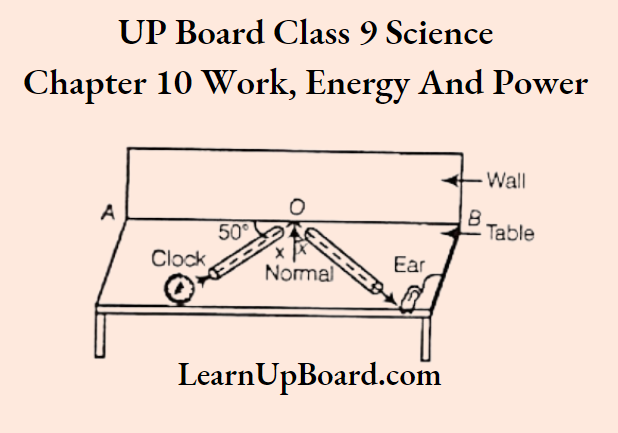
Answer:
We know that in the laws of reflection, the angle of incidence (x) is always equal to the angle of reflection (x). Since AOB is a straight line.
⇒ \(\angle A O B\) =\(180^{\circ}\)
⇒ \(50^{\circ}+x+x+50^{\circ}=180^{\circ}\)
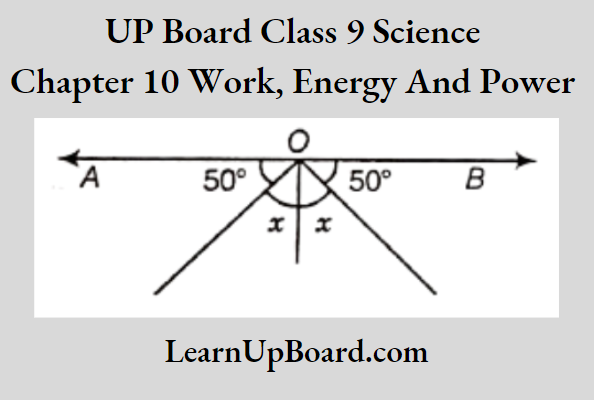
[sum of all angles lies on the same side of a line is \(180^{\circ}\) ]
⇒ \(2 x+100^{\circ}=180^{\circ}\)
⇒ \(2 x=180^{\circ}-100^{\circ} \Rightarrow 2 x=80^{\circ}\)
x=\(\frac{80^{\circ}}{2} \Rightarrow x=40^{\circ}\)
Hence, the value of x is 40°.
Question 47. A boat moving with a velocity of 20 ms1 in a sea is rocked by waves. If its crests are 80 m apart, then at what time does the boat bounce up?
Answer:
Given that, wavelength, \(\lambda\) = 80 m
(Distance between two consecutive crests and troughs is equal to the wavelength.)
Velocity, v = 20 ms-1, time, T = ?
As we know that, T=\(\frac{\lambda}{v}=\frac{80}{20}=4 \mathrm{~s}\)
Question 48. The given graph shows the displacement versus time relation for a disturbance travelling with a velocity of 1500 ms-1. Calculate the wavelength of the disturbance.
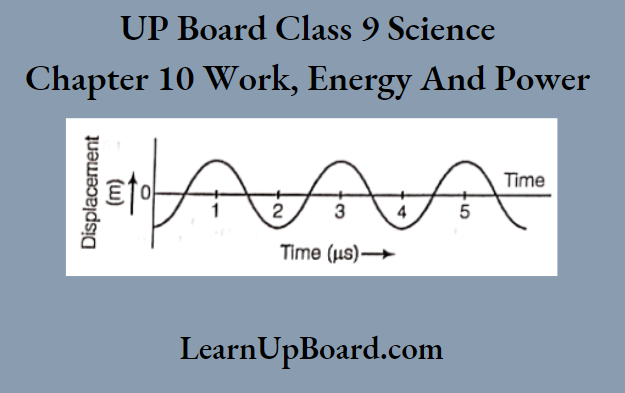
Answer:
Given, velocity, v=1500 \(\mathrm{~ms}^{-1}\)
Time taken in one complete cycle is 2 \(\mu \mathrm{s}\)
Time, T=2 \(\mu \mathrm{s}=2 \times 10^{-6} \mathrm{~s}\left[ 1 \mu \mathrm{s}=10^{-6} \mathrm{~s}\right]\)
We know that,v=\(\mathrm{v} \lambda\left[\mathrm{v}=\frac{1}{T}\right]\)
So, v=\(\frac{\lambda}{T} \Rightarrow \lambda\)=v T
where, \(\lambda\)= wavelength, v= frequency and T= time period
So,\(\lambda =1500 \times 2 \times 10^{-6}=3000 \times 10^{-6}\)
=3 \(\times 10^{+3} \times 10^{-6}=3 \times 10^{-3} \mathrm{~m}\)
Question 49. A construction worker’s helmet slips and falls when he is 78.4 m above the ground. He hears the sound of the helmet hitting the ground 4.23 s after it slipped. Find the speed of sound in the air.
Answer:
Here, s = distance travelled by the helmet to reach the ground =78.4 m
t = total time taken to hear the sound of the helmet hitting the ground =4.23 s
Let it be the time taken by the helmet to reach the ground.
So, we know that, according to the equation of motion, where, u = initial velocity g = acceleration due to gravity.
s=u t+\(\frac{1}{2} g t^2\left[\begin{array}{l}
\text { where, } u=\text { initial velocity } \\
g=\text { acceleration due to gravity. }\end{array}\right]\)
78.4=0 \(\times t+\frac{1}{2} \times 9.8 \times t^2 \Rightarrow 78.4=\frac{1}{2} \times 9.8 \times t^2\)
⇒ \(t^2=16 \Rightarrow\) t=4 s
So, time is taken by the sound wave to travel distance.
78.4 \(\mathrm{~m}=4.23 \mathrm{~s}-4 \mathrm{~s}=0.23 \mathrm{~s}\)
So, speed of sound in air =\(\frac{78.4 \mathrm{~m}}{0.23 \mathrm{~s}}\)=340.86 \(\mathrm{~ms}^{-1}\)
Question 50. A sound wave has a frequency of 2 kHz and a wavelength of 45 cm. It takes 4 s to travel. Calculate the distance it travels.
Answer:
Here, the frequency of sound waves,
v = 2 kHz = 2x 10 3 Hz
Wavelength of the wave, \(lambda\) = 45 cm =0.45 m
Velocity of the wave, v = v \(\lambda\)
= 2 x 103 x 0.45 =900 ms-1
Time to travel = 4 s
Distance travelled by the wave
= vt =900 x 4 =3600 m
UP Board Solutions For Class 9 Science Chapter 11 Sound Long Answer Type Questions
Question 1. (1) What is meant by frequency of sound
waves?
(2) Give the range of frequencies of sound waves that an average human ear can detect.
(3) A source of wave produces 20 crests and 20 troughs in 0.2 s. The distance between a crest and next trough is 50 cm. Find the
- wavelength
- frequency
- period of the wave.
Answer:
(1) Frequency The number of waves produced per second is called the frequency of the wave.
(2) 20 Hz to 20 kHz
(3)(A) Since the distance between a crest and the next trough is \(\frac{\lambda}{2}\).
Therefore, \(\frac{\lambda}{2}\)=50 cm (given)
⇒ \(\lambda\)=100 cm or 1 m
(B) Distance covered in 20 crests =20 \(\times\) 1=20 m
Velocity of the wave, \(\nu=v \lambda=\frac{\lambda}{t}\)
v \(\times 1=\frac{20}{0.2}\)[ t=0.2 s]
v=100 Hz or
1 \(\text { crest and } 1 \text { trough }=1 \text { wave }\)
20 \(\text { crest and } 20 \text { trough }=20 \text { waves }\)
Frequency =\(\frac{\text { Number of waves }}{\text { Time }}=\frac{20}{0.2}=100 \mathrm{~Hz}\)
1 crest and 1 trough =1 wave
20 crest and 20 troughs =20 waves
Frequency =\(\frac{\text { Number of waves }}{\text { Time }}=\frac{20}{0.2}=100 \mathrm{~Hz}\)
(C)Time period, T=\(\frac{1}{\mathrm{v}}=\frac{1}{100}\)=0.01 s
Question 2. Define frequency and wavelength with reference to sound. Explain, what is echo. Give two applications of ultrasound.
Answer:
Frequency The number of complete sound waves (or oscillations) produced in one second is called the frequency of the sound wave.
Wavelength The minimum distance in which a sound wave repeats itself.
Echo The repeddon of sound caused by the reflection of sound waves is called an echo.
Two applications of ultrasound are
- Ultrasound is used in industries to detect flaws in metal blocks without damaging them.
- Ultrasound is used to investigate internal organs of the human body such as the liver, gall bladder, pancreas, kidneys, etc.
Question 3. Establish the relationship between the speed of sound, its wavelength and frequency. If the velocity of sound in air is 340 ms-1. Calculate
- wavelength when the frequency is 256 Hz.
- frequency when the wavelength is 0.85 m.
Answer:
The speed of sound is defined as the distance at which a point on a wave, such as a compression or a rarefaction, travels per unit of time.
We know that, speed, v=\(\frac{\text { distance }}{\text { time }}=\frac{\lambda}{T}\)
Here, \(\lambda\) is the wavelength of the sound wave. It is the distance travelled by the sound wave in one time period (T) of the wave.
⇒ \(\nu=\frac{\lambda}{T}=\lambda \times \frac{1}{T}\)
We know that, v=\(\frac{1}{T}\) [where, v= frequency]
⇒ \(\nu=\lambda v\)
i.e. Speed = Wavelength x Frequency
Given, speed of sound in air, v=340 \(\mathrm{~ms}^{-1}\) and frequency, v=256 Hz
(1) Speed = Wavelength x Frequency
⇒ \(\Rightarrow 340=\lambda \times 256 \Rightarrow \lambda=\frac{340}{256}=133 \mathrm{~m}\)
(2) Again, given wavelength, \(\lambda\)=0.85 m
Then, frequency of sound in air, v=\(\frac{\text { Speed }}{\text { Wavelength }}\)
⇒ {Speed= Wavelength x Frequency}
v=\( \frac{340}{0.85}=\frac{340 \times 100}{85}=400 \mathrm{~Hz}\)
Thus, the frequency of sound is 400 Hz.
Question 4. Draw a curve showing density or pressure variations with respect to distance for a disturbance produced by sound. Mark the position of compression and rarefaction on this curve. Also, define wavelengths and time periods using this curve.
Answer:
We have a curve showing density or pressure variations with respect to distance for a disturbance produced by sound.

Wavelength can be defined as the distance between two successive compressions or rarefactions. It is denoted by λ.
The time taken by the waves to complete one full cycle so that its particles are in the same phase is called time period. It is denoted by T.
